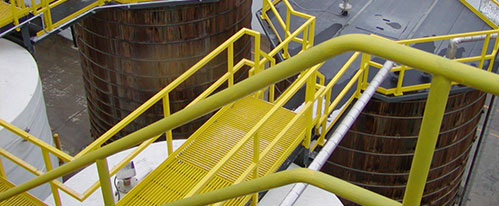Fiber Reinforced Polymers for Cost-effective Handrails
Handrails may serve a number of functions depending upon their application environment, but their fundamental purpose is to provide a secure barrier at the edges of platforms, walkways, and stairwells. A range of metal alloys is used in both industrial and commercial sectors to ensure that railing systems are sturdy enough to withstand constant traffic and infrequent impacts from slips and trips. Fiber reinforced polymers are also used for railing systems in increasingly demanding sectors, after large-scale successes in leisure facilities across the US.

This blog post will explore the cost-benefits of choosing fiber reinforced polymers over metal products for your handrail installation.
What are the Initial Cost Savings?
Fiber reinforced polymer products are typically cheaper than stainless steels with additional chromium alloying contents for enhanced weathering resistance. They are also competitively-priced with aluminum, but savings associated with ease of installation and on-site machining capabilities often makes fiber reinforced polymer handrails the cheaper option.
The SAFRAILTM system from Strongwell can be prefabricated in modular sections and shipped for simple assembly on-site or altered to fit with standard carpentry tools as required. In outdoor applications, components usually operate within a broader margin of error which can be problematic for metal components. If there is an issue regarding the fit of individual metal posts or sections, they must be machined using specialized equipment that can cause delays to installation.
Fiber reinforced polymer handrails can be installed quicker and more cost-effectively than most conventional materials.
What are the Ongoing Cost Savings?
There are a plethora of ongoing cost benefits to fiber reinforced polymer handrails, most of which hinge on the enhanced resistivity of the material over alternatives. Aesthetic detailing can be embedded in the pigment of the SAFRAILTM system, for example, whereas steels and metal alloys must be post-treated with paint which can easily chip and wear away to abrasion from regular traffic. Fiber reinforced polymers are also impervious to rot and corrosion from water, salt, and other harsh media. This makes them perfectly suited to meet an array of project-specific environmental factors, from precipitation and saltwater corrosion in offshore applications to chlorination in leisure facilities.
SAFRAILTM products are fully-resistant to chlorinated pool water of neutral acidity, and salt water with concentrations characteristic of both brackish and seawater. Metal alloys may resist these influences with pre-treatments, but ongoing maintenance will be required to ensure that corrosion does not eliminate the few qualities that make the material desirable for handrail applications.
Fiber Reinforced Polymers from Strongwell
Strongwell leads the market in terms of fiber reinforced polymer engineering for demanding applications. We have provided SAFRAILTM systems for projects as varied as coal preparation plant walkways, employee refuges in the transport sector, and enclosure containment at Sea World in Orlando, Florida.
Our range of fiber reinforced polymer handrails also includes the STRONGRAIL® system, generally used in architectural applications. If you would like to learn more about either of these innovative product ranges, please do not hesitate to contact us.